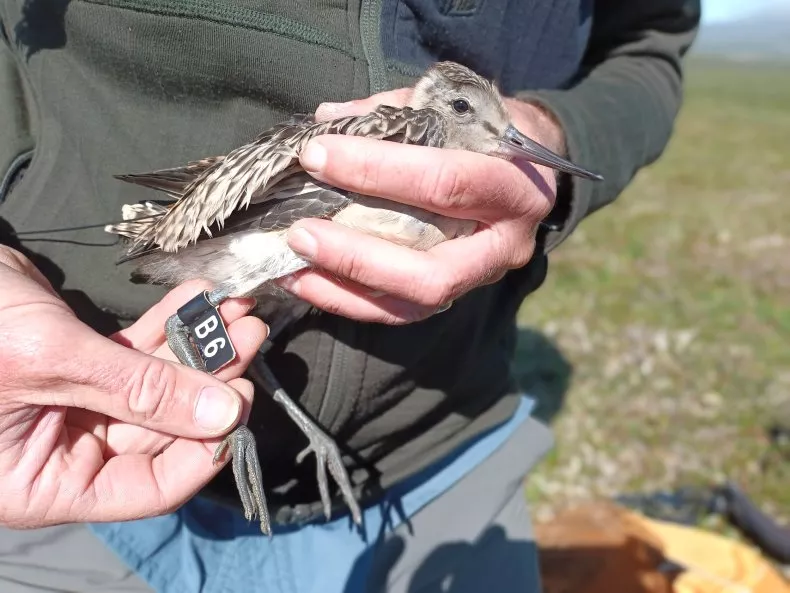A young bar-tailed godwit, identified only by its electronic tag number 234684, has soared 13,560 kilometers without stopping from Alaska towards the Australian state of Tasmania, breaking a new world record for endurance bird flights. The five-month-old bird took off from Alaska on October 13 and satellite measurements indicated that it did not halt during its 11-day, one-hour trip.
This bar-tailed godwit, Limosa lapponica, was tagged in Alaska and traveled at approximately 13,560km (8,435 miles) before landing in Ansons Bay in north-east Tasmania. The longest streak was set by an adult male of the same species - 4BBRW - who soared 13,000km (8,100 miles) last year, breaking his prior record of 12,000km from the previous year, as per the Birding Wire report.

A young bar-tailed godwit is seen when it was first tagged. Named B6, the bird has just completed the longest nonstop bird flight on record, covering 8,400 miles.
Based on a Facebook post from the Pukorokoro Miranda Shorebird Center in New Zealand, 4BBRW's benchmark has been thrown out of the water by this young prodigy. Scientists follow the bird using a 5G micro tag affixed to its lower abdomen.
Setting the New Flight Record
Following data from the Max Planck Institute for Ornithology's bird monitoring project, the migrating bird flew west of Hawaii, over the Pacific sea, and over the Pacific island nation of Kiribati on October 19. The bird would have encountered land again approximately two days later, flying over Vanuatu and then continuing south, adopting a route roughly 620 kilometers east of Sydney and extending between Australia's east coast towards New Zealand.
The bird along with any other birds flying with it turned a sharp right on October 23 and flew west, arriving in Tasmania on October 25. The most astonishing thing is that youngsters move independently to the adults, said Sean Dooley of BirdLife Australia. Adults depart from the Arctic as much as six weeks sooner.
Juveniles would use that opportunity to bulk up for the lengthy journey south. Such a bird was most likely part of a flock. This is a record for continuous flight, and it's simply remarkable, as described by Dooley. He claimed that the birds were able to reduce their vital organs to make more room for fat storage.
The Pukorokoro Miranda Shorebird Center stated that it had prepared souvenir hand towels for former record holder 4BBRW and that it may now have to make a fresh set.

A new flight record soared by a bar-tailed godwit as it flew 8,000 miles for 11 days.
ALSO READ: Hundreds of Migratory Birds Simultaneously Died Above the Sky of Mexico in a Mysterious Event
Bar-tailed Godwit During Migrations
When the time comes for migration, barely a few months after spawning, young godwits accompany yearling and mature godwits on their rigorous first journey. Some Bar-tailed Godwits might stop at New Caledonia or Australia, but the majority will travel directly to New Zealand. The precise distance traveled varies depending on the flock and individual. The species make navigating decisions to maximize beneficial winds and avoid bad weather, and even a variation of one-tenth of a degree in the beginning angle of their migratory route can add or subtract length from their long-distance journey, added by BirdWire report.
Despite all of these uncertainties, godwits are surprisingly precise and constant, flying to the same locations every year and departing on their migrations in a matter of days. When it comes time to head back to Alaska in April and March the Bar-tailed Godwits take a different path, flying north to mudflats developed along the Yellow Sea shoreline in South Korea, whereupon they graze and rest before flying northeast to Alaska.
Populations of Bar-tailed Godwits have been dropping globally as a result of increasing challenges from habitat destruction and climate change. Researchers who are tracking this species want to know if somehow the birds are responding to habitat degradation and finding alternative migration routes.
RELATED ARTICLE: Earth's Magnetic Field Help Migratory Birds Know Which Direction to Head and How to Return to Nesting Sites
Check out more news and information on Migratory Birds in Science Times.














